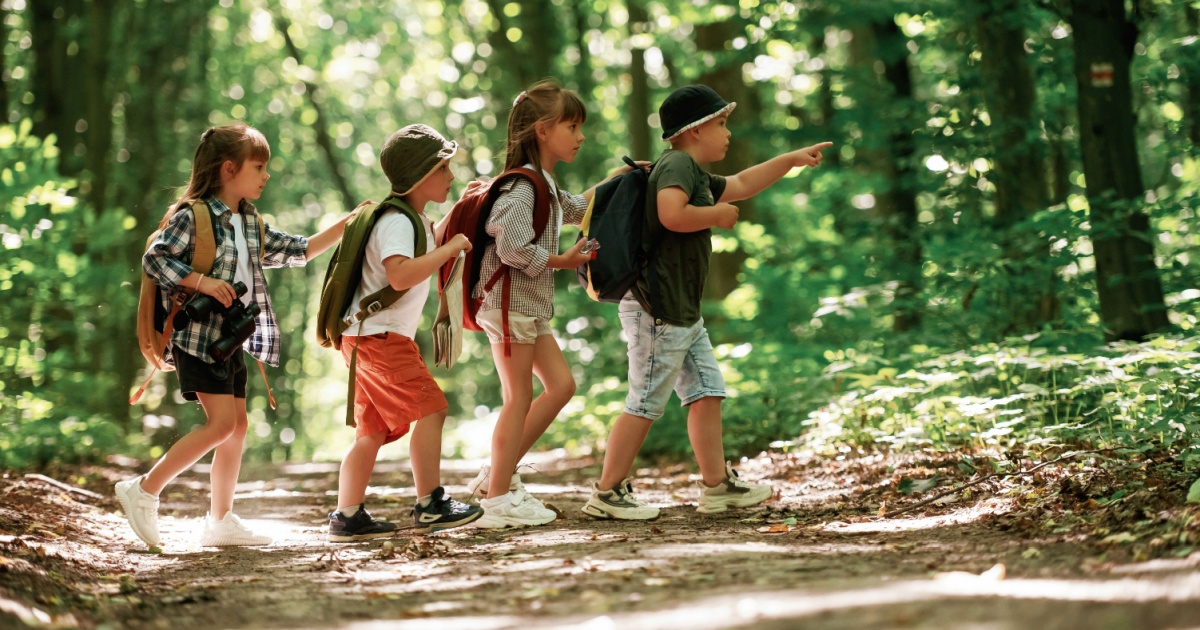One day, my eldest declared himself an “indoor cat.” We live in a large, smog-filled city, and even though we have a nice backyard, my children rarely played in it. I wanted my family to connect more to nature, but I needed a strategy.
Then, I found a post in a local Facebook group advertising an adventure group for families. Intrigued, I emailed the woman in charge. She sent me the list of hikes and day adventures she organized for that fall and winter. I emailed her back with a few dates we were available to attend.
That commitment forever changed my mothering and our family’s connection to nature. Here are five tips I learned along the way.
My children, often whiny and easily tired while hiking, became energetic and chatty when we hiked with their peers. I, too, found I could tolerate them longer on the trail.
I spoke with Jaclyn Spinelli, a registered psychotherapist and CEO, owner and clinical director of True Self Counselling, to ask why peers can be motivating on trails for adults and children alike. She explains, “We tend to hike for longer in the presence of others because our nervous systems ‘co-regulate’—meaning they sync to each other. When we feel safe, seen and connected, movement becomes joyful rather than an effort.”
Spinelli also says group hikes can “stimulate visual engagement and social mirroring,” which engages the brain regions linked to “creativity, calm and motivation” that help us keep moving and socializing.
Our children follow our lead. If I wanted mine to interact with nature, I needed to model interest. I purchased local field guides, downloaded bird and tree identifying apps (highly recommend Merlin Bird ID) and checked out flora and fauna books from our library.
We studied the difference between deciduous and coniferous trees, spent months in a nature curriculum targeted to our Sonoran desert and raised butterflies to learn about their cycles.
Best of all, we took daily nature walks, sketching what we saw along our path and bringing home scraggly wildflowers or seed pods to display on our kitchen table.
Another benefit of modeling nature attachment is stewardship. We purchased a compost bin, took a better initiative to recycle and learned the rules of “pack in/pack out” on trails.
Phillip Kilbridge is the president and CEO of NatureBridge, an outdoor education nonprofit and the largest education partner of the National Park Service—one that brings over 30,000 young people each year to their campuses for transformative immersive experiences in national parks around the country. “For kids, time in nature lays the foundation for something much deeper than curiosity,” says Kilbridge. “It builds a relationship. When kids connect to the natural world, stewardship becomes a natural response.”
I’ve noticed many families hike quickly, as if trying to stay ahead of the meltdowns. But I learned that the longer I spent with my children in nature, the more connected they became to it. Around hour two, they often complain of boredom, but I firmly tell them we aren’t leaving yet. Their boredom usually turns into something impressive, like a tree branch house, a good rock climbing expedition or a new game.
Boredom helps foster better creativity and emotional regulation, says Spinelli. She adds that nature invites children to slow down in a world of endless entertainment and stimulation. “Without screens or structured agendas, they learn how to be present with what is—to sit in silence, follow a bug or simply daydream under a tree. This ability to tolerate ‘nothingness’ becomes the foundation for self-soothing, creative thought and deeper emotional regulation,” she says.
Persistent exposure to nature builds a child’s stamina, especially when inclement weather is involved.
Kilbridge says, “Persisting outdoors teaches children how to be uncomfortable and still succeed. They learn how to keep going when something feels hard, how to adapt when things don’t go as planned and how to support each other along the way. These experiences build character and skills like perseverance, empathy and teamwork. Kids carry these back into their classrooms, families and communities. In short, the outdoors becomes a powerful teacher.”
Spinelli urges parents to stay “calm, grounded and non-reactive” if a child whines on a nature outing. When a parent’s energy stays steady, it helps a child follow the rhythm and push through, too. She suggests small challenges as a tool to redirect a child’s focus, such as asking a child to find ten different types of flowers or leaves.
My son loves geocaching, my daughter prefers to do crafts using nature’s offerings and my husband loves the incentive of a good road trip—bridging their interests helps them engage deeper with nature.
“When we link outdoor time to our children’s natural interests, we give them a reason to get outside—and once they’re there, nature does the rest. Whether kids know the reason why or not, they know they ‘feel better’ outside. As their nervous systems settle, they become more present—and it’s in those moments that a relationship with nature can begin to develop,” Spinelli says.
Since we started engaging with nature more, my children frequently explore our backyard. It’s as if nature time begets more nature time. I encourage you to try even one of these tips and see how it might deepen your family’s bond with the natural world.
Photo from Standret/Shutterstock.com

